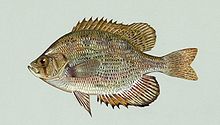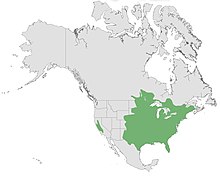Centrarchidae
| Sunfish Temporal range:
Late Eocene to Recent | |
|---|---|

| |
| Flier (Centrarchus macropterus) | |
| Scientific classification | |
| Domain: | Eukaryota |
| Kingdom: | Animalia |
| Phylum: | Chordata |
| Class: | Actinopterygii |
| Order: | Perciformes |
| Superfamily: | Percoidea |
| Family: | Centrarchidae Bleeker, 1859[1] |
| Type species | |
Centrarchus macropterus
, 1801 | |
| Subfamilies | |
|
See text | |

| |
| Centrarchidae native range | |
Centrarchidae, better known as sunfishes, is a
The centrarchid family comprises 38 identified
Description
Family members are distinguished by having a laterally compressed body shape, 6 to 9 anal spines, and 2 dorsal fins (spinous first dorsal and rayed second dorsal) which are fused.
Many of the species within Centrarchidae can be separated into two main groups based on the two most common genera (Micropterus and Lepomis). Species in the genera Lepomis are defined by a deep or more round body shape, smaller mouths, and obtaining food through suction feeding.[2][7] Species in the genera Micropterus are defined by a more streamlined body shape, larger mouths, and consuming prey primarily by ram feeding methods.[2][7]
Habitat

Centrarchids prefer clear, warm, and slower-moving water, and are commonly found in habitats such as lakes, ponds, medium to low flow streams and rivers, and swamps.[8] They also prefer to live in and around aquatic vegetation so they can get adequate coverage from predators. While few species in the family diverge from the aforementioned habitat list, the Sacramento perch can survive in habitats with unusually high alkalinity, salinity, and temperatures.[8] Centrarchids can be found in various locations within the water column and their exact preference is species specific. For instance, bluegill (Lepomis macrochirus) mainly inhabit the deeper littoral zones, while green sunfish (Lepomis cyanellus) prefer habitats near the shoreline and shallower areas.[9] Suction feeders within the family (i.e. Lepomis) generally feed off the bottom of their habitat, while ram feeders (i.e. Micropterus) generally feed in more open areas known as the limnetic zone.[10] Centrarchids diet consists of macro-invertebrates (e.g. insects, snails and crayfish) and other fish found in their habitat.[8]
Thermal tolerance
In freshwater systems, water temperature is determined by many abiotic factors, with air temperature being one of the most significant contributors.[11] As in other ectotherms, many physiological processes and behaviors in Centrarchidae, such as feeding and reproduction, are heavily impacted by the temperature in their environment.[12] All species in the family Centrarchidae are considered warmwater adapted species.[13] In general, warmwater adapted species are characterized as being larger at higher temperatures and lower latitudes.[14] The optimal temperature range of most species in the family is 28 °C(82 °F) to 32 °C(90 °F), although they can survive and reproduce in temperatures that are outside of this optimum range.[7] Increases in temperature outside the optimal range for centrarchids can have negative effects, such as speeding up reproductive maturity or increasing mortality after the first reproductive event.[15] The lethal temperature range varies widely in the family, but some species have been seen to survive water temperatures as low as 1 °C(33 °F) or as high as 41 °C(106 °F).[16]
Reproduction
Centrarchids generally spawn in the spring, and juveniles emerge in the late spring to early summer.[17] The transition from winter to spring conditions (i.e. melting of ice-cover, increase in day length, and increased food availability) is the main cue for centrarchids to begin preparing for reproduction.[12] All species within Centrarchidae, except for those in the genus Micropterus, develop breeding coloration in both males and females (although less defined in females) during the breeding season.[2] The process of courtship and reproduction is nearly identical for all species in the family, which is a major reason for the high levels of hybridization within Centrarchidae.[18] With that said, there are some mechanisms in place to prevent hybridization, such as intricate morphology of the operculum in Lepomis, which assists in recognition of conspecific mates.[2]
To initiate reproduction, males dig a deep circular depression in the substrate with their caudal fins to create a nest,[8] which they will aggressively defend from intruding males.[2] Males and females then undergo a courtship dancing ritual before the female deposits her eggs into the male's nest.[8] Multiple females may deposit eggs in a single nest.[7] Larger males usually attract more mates and also take better care of their offspring.[19] Male parental care includes nest building, nest guarding, guarding of eggs and fry, and nest fanning (aerating eggs).[20]
Males unsuccessful at courtship may exhibit a cheater strategy where they sneak fertilizations of female's eggs by various behavioral methods.[21] This is commonly seen with smaller males in the genus Lepomis.[5]
Range

The native range of Centrarchidae is confined within North America, covering most of the United States and stopping in southern Canada. The northern edge of the native range is heavily bound by temperature due to reduced foraging ability and growth in cold weather and subsequent starvation in winter months.[7][22] As a result, centrarchid distributions and range in any place they are found will be restricted by cold temperatures.[7]
Range shifts
The ability to adapt to cold temperatures at the edge of the sunfish range varies widely within the family. Largemouth bass (Micropterus salmoides) have no cold acclimation ability as seen through the strict maintenance of the northern boundary of the species range.[23] Other species like smallmouth bass (Micropterus dolomieu) and green sunfish (Lepomis cyanellus) have exhibited signs of minor cold-water adaptation and have even experienced slight range expansions into colder habitats.[23]
If air temperatures continue to rise in the next 50 to 100 years as predicted,[24] warmwater species like centrarchids will likely experience range expansions northward and see an overall increase in occupiable habitat.[25][11] This range expansion can have grave consequences for other freshwater fishes however, as many centrarchids are dominant top predators which can severely alter the community structure of non-native ecosystems and drive the extinction of other native predators.[26]
Invasive range
While centrarchids are native to only North America, they can be found worldwide due to introductions on multiple continents, including Europe, South America, Africa, and Asia.[8] At least 18 species of Centrarchidae are North American exports.[7] Its multi-continental spread is mostly due to the high popularity of the family (especially from the genera Micropterus) as freshwater game fish that are frequently stocked for recreational fishing all around Europe.[7][8]
Across the globe, invasive and introduced centrarchids pose a great threat to native species in the areas they invade.[7][27] There are multiple confirmed instances of largemouth bass (Micropterus salmoides) severely altering and reducing native fish populations in Italy, South Africa, Japan, and Madagascar and even causing the local extinction of any species of the family Cyprinodontidae within the waterbodies they have invaded in Mexico.[7]
Fossil record
The earliest fossils of Centrarchidae are from
Classification
Recent genetic evidence suggests the following taxonomy of the centrarchid genera and species:[29][30]
| Centrarchidae |
| ||||||||||||||||||||||||||||||||||||||||||||||||||||||||||||
The 5th edition of
References
- PMID 25543675.
- ^ S2CID 17580461.
- ^ http://www.nanfa.org/ac/AC2012vol37no4_Elassoma%20zonatum%20E_okejenokee%20and%20E_evergladei-habitats%20and%20comparative%20observations_Bohlen_Nolte.pdf [bare URL PDF]
- S2CID 198155858.
- ^ OCLC 651912235.
- ISBN 978-0-12-547665-2.
- ^ a b c d e f g h i j Soes, Menno; Cooke, Steven; van Kleef, H.H.; Broeckx, P.B.; Veenvliet, P. (March 21, 2010). "A risk analysis of sunfishes (Centrarchidae) and pygmy sunfishes (Elassomatidae) in the Netherlands". Bureau of Waardenburg bv. pp. 1–110. Report nr 11-042 – via ResearchGate.
- ^ ISBN 978-0-226-04442-2.
- JSTOR 1936222.
- PMID 15472018.
- ^ PMID 21078096.
- ^ S2CID 18297554.
- ISSN 0066-4162.
- S2CID 22642325.
- ISSN 1095-8649.
- S2CID 35400804.
- ^ Miranda, L.E. (Steve) (Winter 2014). "Fish in Winter – Changes in Latitudes, Changes in Attitudes" (PDF). Lake Line (a publication of the North American Lake Management Society). Vol. 34, no. 4. pp. 28–31. Archived (PDF) from the original on 2018-04-03.
- S2CID 85691602.
- ISSN 0008-4301.
- ISSN 0024-4082.
- PMID 16592922.
- S2CID 85651008.
- ^ S2CID 36858254.
- ^ IPCC, 2014: Climate Change 2014: Synthesis Report. Contribution of Working Groups I, II and III to the Fifth Assessment Report of the Intergovernmental Panel on Climate Change [Core Writing Team, R.K. Pachauri and L.A. Meyer (eds.)]. IPCC, Geneva, Switzerland, 151 pp. https://www.ipcc.ch/report/ar5/
- (PDF) from the original on 2019-05-01.
- ISBN 9781444316032.
- .
- ^ S. J. Cooke; D. P. Philipp (2009). Centrarchid fishes: diversity, biology, and conservation. Blackwell Publishing Ltd. pp. 1–38.
- S2CID 86167841. Archived from the original(PDF) on 2017-09-14.
- PMID 16329246.
- ^ Froese, Rainer, and Daniel Pauly, eds. (2019). "Elassomatidae" in FishBase. December 2019 version.
- ISBN 978-1-118-34233-6. Archived from the originalon 2019-04-08. Retrieved 2020-05-18.
External links
- Froese, Rainer, and Daniel Pauly, eds. (2004). "Centrarchidae" in FishBase. October 2004 version.
